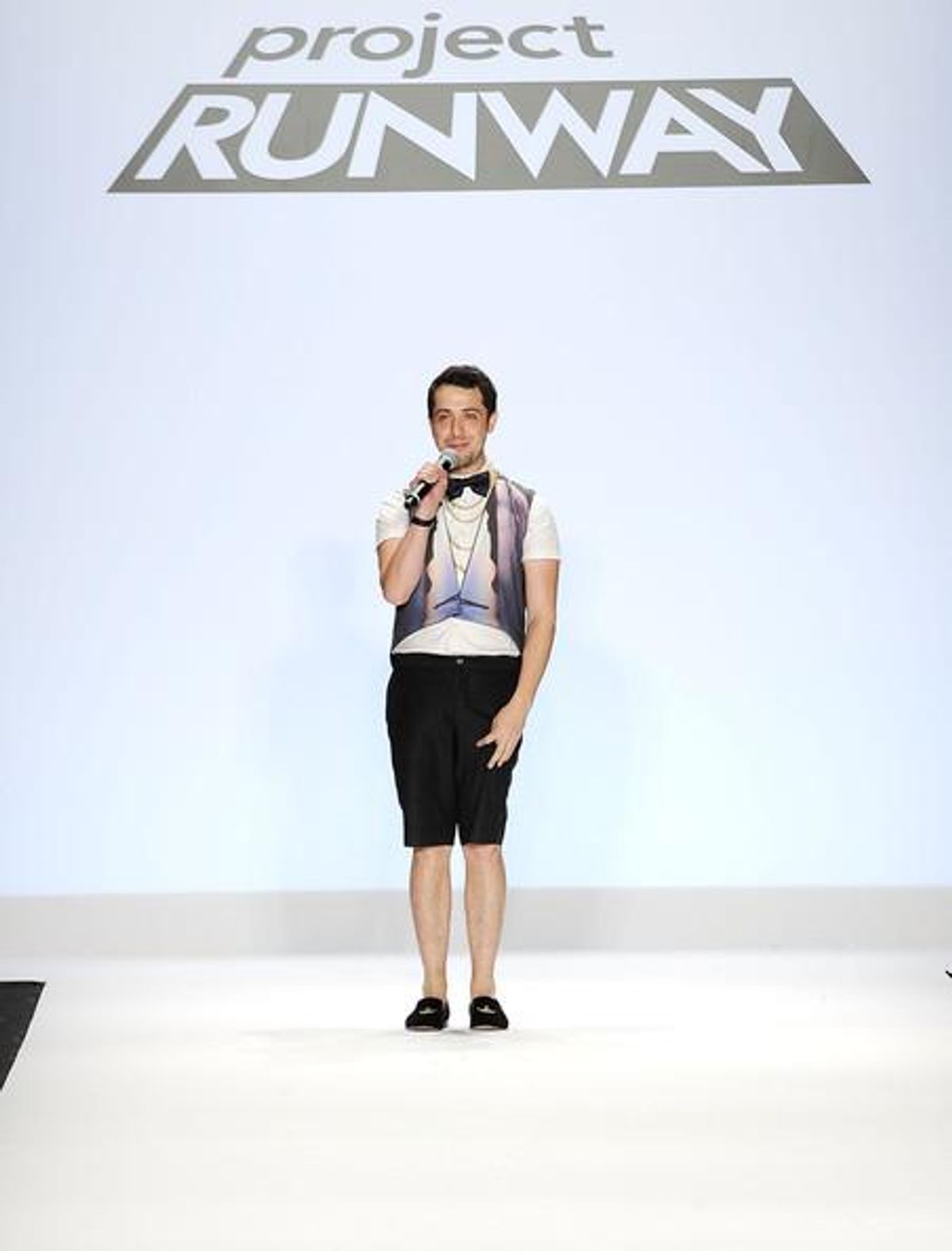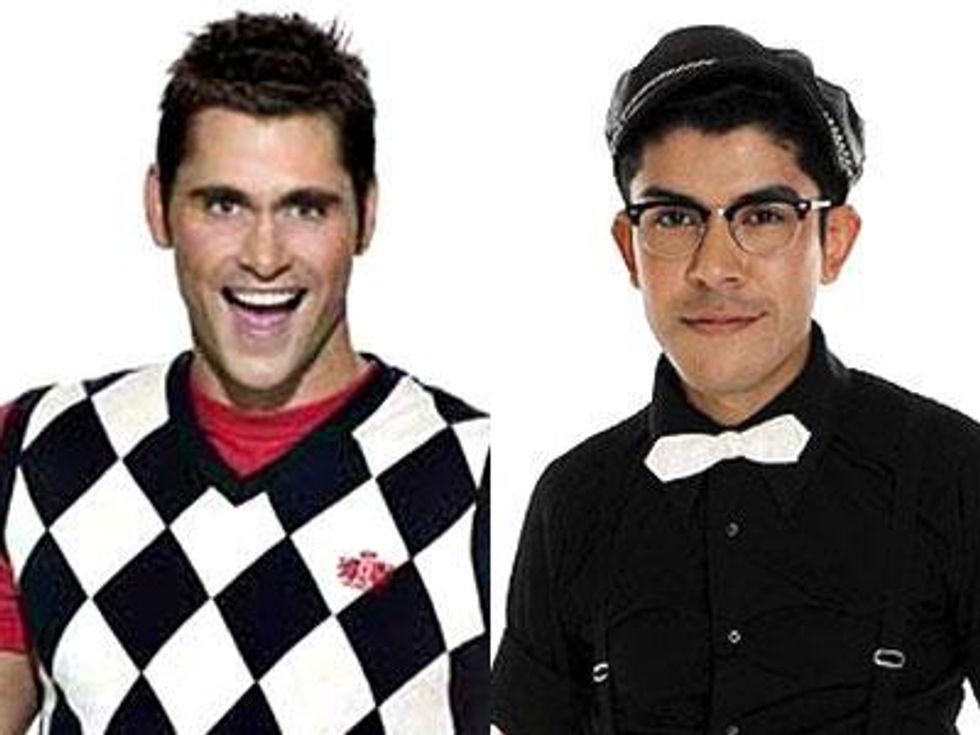Over the course of a dozen seasons, the fashion competition series has tackled everything from drug addiction to racism to gender reassignment among contestants, and it has hosted more HIV disclosures than any other reality show. The latest addition to the trend is designer Viktor Luna, the contestant who sports the fluttering handheld fan on the current season of Project Runway: All Stars.
Exactly how these disclosures have come about over the years is a study in contrasts, as different as the three HIV positive contestants themselves – and the whims of show producers.
In 1998, season four of Project Runway introduced the world to designer Jack Mackenroth, the competitive swimmer, model, and all-around sex symbol who had already been living openly with HIV for 17 years. His casual disclosure during an early direct camera interview during his season showed a man comfortable with himself and his status.
"The producers knew I was positive because we fill out a stack of background information," Mackenroth told HIV Plus. "They had my entire medical history, like every other contestant on the show."
Already an HIV advocate at the time, Mackenroth knew the producers would eventually use his HIV as a dramatic device, but "that was fine with me," he said, "because I saw it as an important tool as well, for HIV visibility and as a chance to fight
stigma."
That opportunity was lost when fate intervened. Before he could disclose to his fellow contestants on camera, Mackenroth developed a serious infection unrelated to HIV that forced him to withdraw from the show five episodes into the season.
"Tim Gunn sat me down and reassured me," said Mackenroth. "He told me that everything happens for a reason, and in that moment I was like, Yeah, right. I was exhausted and emotional. But the truth is, that show gave me my platform. It worked out great."
It would be years later until an HIV positive contestant would actually disclose their status to the cast on camera, but when it finally happened it brought all the drama and emotion the famously controlling Project Runway producers could ever imagine.
In 2010, season eight of the series included Mondo Guerra, an insanely talented young designer who was as guarded as he was endearing. Although one should be mindful that footage is carefully edited to create characters and increase drama, Guerra certainly seemed like an artist with a painful secret or two.
During a challenge to create an original textile, Guerra designed a graphic print with a conspicuous "plus" sign throughout it. In direct camera segments, he revealed that the design reflected his HIV-positive status but otherwise kept his inspiration to himself, having not disclosed to even his own family at that point.
When pressed on the runway later to explain his design, Guerra demurred again. The judges stared in wonder. The music swelled. Filled with nervous emotion, Mondo haltingly revealed his HIV status as the inspiration for his textile. Viewers saw not only his tears but something more: a humble sort of triumph.
"I feel free," Guerra said plainly.
Guerra's disclosure was given generous air time during the episode and was the dramatic centerpiece of the entire season. The moment has been replayed endlessly on YouTube and was shown to a packed ballroom at the 2013 United States Conference on AIDS. It was undeniably inspiring, seemingly spontaneous, and brilliant television.
"Knowing Mondo, I think that happened organically," said Mackenroth. "Of course, everyone is working nonstop, producing a full season in 35 days. When these vulnerable situations come up, we hardly have time to think it through."
"When the judges genuinely wanted to know the story behind my print and design, that felt like the right moment," Guerra told HIV Plus. "So I told them what it really represented and that moment was a turning point in my life."
If Mondo provided the pinnacle of televised disclosures, the current season of Project Runway: All Stars has given us the most curious presentation of The Big Reveal.
In a recent episode, designer Viktor Luna and the cast were scampering about, hard at work, and suddenly Luna begins speaking of his great anxiety in voice-over. Something is weighing heavily on him. He takes two designer pals aside and quickly shares his HIV-positive status. His friends say supportive things, they hug, and then they all dash back to their sewing machines as if they'd just had a quick smoke break. Luna's status is never mentioned again.
Luna's disclosure, as edited, felt like an afterthought, as if the producers noticed a lull in the excitement and cued Luna to bring on the drama. Producers might have hoped for something touching, but the hurried editing actually minimized the complicated nature of HIV disclosure. Everything about it felt false.
You know we are living in a more fortunate time when the merits of one televised HIV disclosure over another are being argued.
"Regardless of how it's produced, it's all a win," says Mackenroth. "Whenever this or any show combats stigma, the HIV community benefits from it."
Guerra sees a personal benefit too.
"Personally, it wasn’t until I was open about my status that I started to take better care of myself," Mondo told us. "For that reason, I applaud Jack’s openness about his status."
Today, Mackenroth continues his advocacy as one of the creators of the
HIV=Equal campaign. Guerra has entered the fashion design stratosphere and is a key player in the
Project iDesign Campaign, which encourages doctor/patient partnership. Luna wrote about his HIV disclosure on
Huffington Post, sharing the details of his HIV journey that were not included in his
Project Runway: All Stars episode.
Nothing is assured, in fame or fashion. Project Runway contestants are often struggling designers who leave whatever jobs they have to compete on the show. For any of them to put their personal lives on the line, to take the sometimes frightening step of revealing their HIV status to the world, takes a special kind of courage.
Many people with HIV may not be fashion designers, but they can certainly relate to that.


